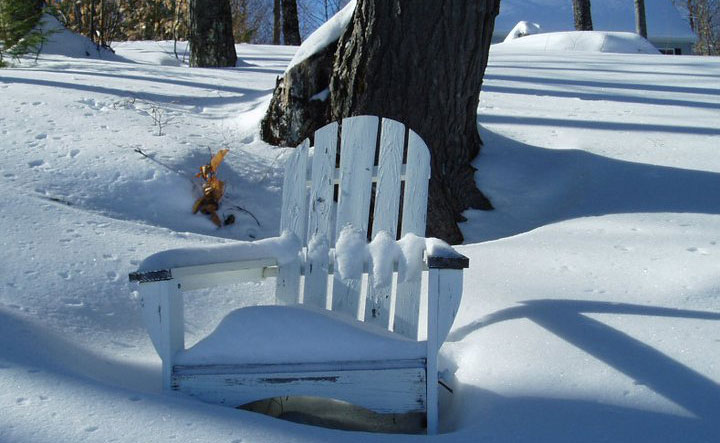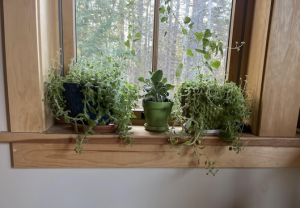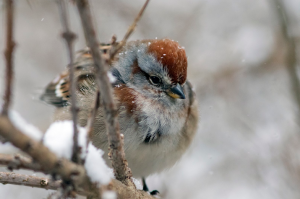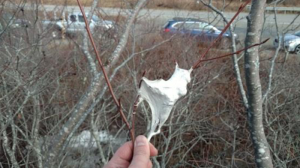
Maine Home Garden News February 2023
In This Issue:
- February Is the Month to . . .
- Featured Tool: Soil Blockers
- Backyard Bird of the Month: American Tree Sparrow
- Winter Farmers’ Market Gleaning
- Do You Know the Four Rs to “KNOCK OUT” Browntail Moth?
- Kale and White Bean Soup
- Ask the Expert
February Is the Month to . . .
By Sandra Mitchell, Penobscot County Master Gardener Volunteer
February is the month to be restless! The days are longer, and everyone is anxious to sprout, bud, garden, and plant – but it is still too early. For reference . . . on December 21, we only had 8 hours, and 47 minutes of light. But by February 15, we’ve skyrocketed to 10 hours and 27 minutes! And by the end of February, we’ll be up over 11 hours! Yee-haw!
 If you are like me, you just can’t wait to start those tomato seeds. The promise of August fruit is so alluring. But don’t do it! You’ll only wind up with leggy, sickly seedlings. This doesn’t mean you can’t start ANY seedlings – content yourself with onions, leeks, parsley, pansies, and green leafy-like lettuce that you can put out under a hothouse when they are big enough.
If you are like me, you just can’t wait to start those tomato seeds. The promise of August fruit is so alluring. But don’t do it! You’ll only wind up with leggy, sickly seedlings. This doesn’t mean you can’t start ANY seedlings – content yourself with onions, leeks, parsley, pansies, and green leafy-like lettuce that you can put out under a hothouse when they are big enough.
Of course, if you haven’t already done so, February is the month to browse through seed catalogs and dream of all of the things you are going to plant. It is also a good month to sketch out your garden plan – remember that garden space, water, and time are not unlimited! Putting 25 squash in small raised beds doesn’t work well for anyone. I will not overload myself on squash . . . I will not overload myself on squash . . . I will not . . .
Don’t forget to consider ordering bare-root trees and shrubs. I planted quite a few last year and was amazed at how quickly they took off. And while you are ordering – inventory your tools and supplies. You don’t want your tools to be rusted and dull when you go out to prune those apple trees!
Another good project for a snowy afternoon is to inventory the seeds that you do have and test them for viability. Take some time to get out your seed starting gear. Make sure all the lights work, and wash your flats and such in 1:10 bleach/water to help prevent damping-off of your precious new seedlings.
Something that is often overlooked or forgotten is to check your stored vegetables – remember the saying about one bad apple? Well, it is certainly true! By now, your garlic and onions might be looking a little, well, ragged and maybe even sprouting. Did you know you can save them for eating by putting them in the freezer? While you are at it, remember to check the tender ornamentals like dahlias that you’ve stored in the cellar. They may need a spritz of water, or if they are getting soft, may need to be culled. And if you raise bees, keep in mind that due to our warm/cold/warm/cold winter, they might have worked through their food stores. It could be time to add sugar boards.
February is also a good month to check for obvious winter damage and prune out dead and damaged branches, as well as clean out your fruit trees. But be sure not to cut back spring flowering plants like lilacs, magnolia, quince, and forsythia, or they won’t bloom this year. While trimming, check for viburnum beetle egg cases on the underside of young twigs – and remove these while you can. And, as long as you are out pruning, bring in some branches to force. Great choices include pussy willow, apple, cherry, and forsythia.
 And lastly, don’t forget your houseplants. Like us, they perk up in response to the longer days, and now is the time to start feeding them half-strength fertilizer when you water.
And lastly, don’t forget your houseplants. Like us, they perk up in response to the longer days, and now is the time to start feeding them half-strength fertilizer when you water.
And take heart! The days are getting longer and soon you’ll be back out and working the soil. Just don’t dig before it is dry, or you’ll compact the soil and be sorry later in the season. Save the earthworms, and wait for the frost and mud to leave the garden before walking on even the paths!
Featured Tool: Soil Blockers
By Kate Garland, Horticultural Professional, UMaine Extension Penobscot County
Gardeners are faced with a dizzying variety of tools and supplies promising to help you accomplish your horticultural goals. Some turn out to be game-changers while others end up at the thrift store. Over the next several months, we’re asking Master Gardener Volunteers and horticulture professionals to share their favorite tools and resources with you, so you can hear what fellow Maine gardeners find most helpful.
We’ll kick things off with a tool suggestion from Christina Lannan, a Penobscot County Master Gardener Volunteer deeply committed to school gardening and food security efforts in the Old Town region. Christina starts thousands of seedlings in her role as a volunteer and agriculture professional. One of her favorite tools for the job is a soil blocker. This hand-held tool is used to compress seed-starting media into tidy blocks. In addition to reducing the use of plastics, the blocks produce seedlings that are easy to water, pull apart nicely at transplanting time, and have a healthy root system without any signs of restricted root growth.
Here are a few tips for success:
Video: Featured Tool: Soil Blockers (YouTube)
Step-by-Step Caption Transcript for the Video: Featured Tool: Soil Blockers (YouTube)
- Timestamp: 0.09: Use a well-drained seed starting mix (i.e. not soil from your garden) and make sure it’s soaked to the consistency of wet cement. Another way to picture consistency is to imagine making mud pies. While it will be quite wet, Lannan says “It should have some structure and be able to hold its shape.” There are many good recipes for soil blocker seed starting mix, but you might want to start simple with a standard peat-based seed starter or a blend specifically formulated for the blocker. Christina is using a standard peat-based seed starting mix from Coast of Maine*. We have brainstormed options for reduced-peat alternatives that would involve mixing in some additional compost or coir and will share any successes in future articles.
- Timestamp: 0.50: Soil blockers come in different sizes. If you were to buy just one, Lannan recommends either the 4 cell 2” blocker or the 5 cell 1.5” type. She uses the 5 cell the most, saving the 4 cell for larger seedlings such as cucumber, squash and melon.
- Lannan places soil blocks in a sturdy netted tray nested in a leak-proof tray. She removes one corner block to provide a spot for gentle watering that won’t risk washing out neighboring blocks.
- Timestamp: 2:11: After sowing seeds, she gently dusts screened mix over the top, except for those seeds that require light for germination. Screening isn’t 100% essential but is very helpful when mixes contain a higher amount of coarse material and/or when you are working with fine seeds.
More information: Soil Blocking in Five Easy Steps (Small Farms, Cornell website).
We hope that hints from fellow Maine gardeners like this and the ones to come will lead you to tools and strategies that make your gardening adventures more rewarding and fun.
Backyard Bird of the Month: American Tree Sparrow
By Doug Hitchcox, Maine Audubon Staff Naturalist

Is that a Chipping Sparrow hopping around under your feeder in the middle of winter? Not quite! It is most likely an American Tree Sparrow. These lookalikes were in the same genus until recently (Spizella), along with several other small, rufous-capped sparrows. American Tree Sparrows are the hardiest of the bunch, only showing up in Maine in late fall, just when the last Chipping Sparrows start to head south. Don’t be fooled by the name: they are almost always seen on the ground, in both their breeding and nonbreeding habitats. They spend the winter here, foraging for seeds under feeders and in fields. Come spring, they will return to their breeding grounds at the treeline on the edge of the Arctic tundra in northernmost Quebec and Labrador, where they nest on tussocks of grass or hummocks of moss near the ground. Little is known about their breeding habits in these remote locations, so be sure to enjoy them while they are in your yard this winter!
For more on the importance of Maine native plants to support birds like American Tree Sparrow and other wildlife, visit Maine Audubon’s “Bringing Nature Home” webpage.
Gleaning at a Winter Farmers’ Market
By Lynne Holland, Horticulture and Social Media Professional and Cumberland County Master Gardener Volunteer
Many Master Gardener Volunteers have enjoyed the experience of gleaning at farmers’ markets in the summer, but might not be aware that winter market gleaning is also a great way to help farmers ensure that their gorgeous unsold produce lands on plates instead of a compost pile. The “haul” may not be as varied and bountiful as you’d find in August but can yield a surprising mix of goods. I’ve had the pleasure of gleaning the Brunswick Farmers’ Market for three years. Many are curious about how it all works, so I’ll share a little bit about the process, impacts, and tips for success.
Q. What can you glean from a winter market?
A. That varies by month and week. In early winter we see the end-of-season crops like apples, potatoes, winter squash, and some less hardy vegetables. By Christmas, it was all the hardier food, especially root veg and storage items. After I had been gleaning long enough to develop relationships, vendors of baked goods, eggs, bread, prepared meals, and even some indoor greens were also donated. Some vendors of long-coded items like jellies and sauces will donate the last of their earlier batches when a new batch is ready.
Q. What impact does the gleaned food have on the individuals being served?
A. The variety of items is really helpful for families in public housing or meal-making sites. One “chef” at a kitchen that makes lunches every Tuesday would plan that meal around the food they got on Monday from the Saturday Market. The soup or casserole of the week would be different each time.
Q. What feedback have you received from vendors?
A. One bakery told me they loved knowing their extra food would be given to someone in need. Though they had good intentions of donating to their local pantry, the schedules never meshed. Another farmer said that having me take the leftovers off his hands on Saturday saved him a trip on Monday. It was super important to all of them that the produce they worked so hard to grow and bring to market would be on someone’s table rather than in the compost or trash.
Q. What do you enjoy about the experience?
A. As an extrovert who wants to support my local food system, gleaning at the Farmers’ Market was like being the “queen of the market” for an hour each week. I checked in with “my” vendors/friends each week and literally had a trail of stuff accumulate behind me as I walked down the aisles. Vendors would drop off items in the corner where my boxes were piled as they cleared out and headed for home. It was social as much as volunteering. Vendors often would include “something for me” as a thank you and I always got to taste great samples. I usually did this with another volunteer or my husband which made it even more fun.
Q. Who’s making this magic happen? Do you need more helpers?
A. There is always a need for volunteers. Merrymeeting Gleaners and Androscoggin Gleaners both glean at markets in Brunswick, Bath, and Lewiston. To learn about gleaning efforts in other parts of the state, consult the Maine Gleaning Network, The Maine Federation of Farmers Markets Gleaning Guide, or your local Extension office.
Q. Who makes a good volunteer?
A. Regular farmers’ market shoppers make excellent gleaners. You won’t need a truck since a car almost always has plenty of room for what’s gathered. It’s helpful to be able to lift about 20 lbs, but smaller boxes can be used if weight is an issue. Most importantly, volunteers need to be willing to meet and talk to the general public, farmers, and vendors. This work is very public-facing and gleaning volunteers are ambassadors in the community.
Q. How does the process work, and what are some tips for success?
- Market gleans should be arranged in advance with the vendors at the market. Arrive before the end of the market and distribute boxes or crates to the vendors who have agreed in advance to donate.
- This first trip around the market is a good time to introduce yourself, explain to curious folks what you are doing, and answer questions.
- Never interrupt a vendor during a sales transaction to give them the boxes. Hang back and wait for them to have a free moment.
- If you are shopping at the market, this is a good time to do that. Showing you are supporting the local farmers is always a good thing.
- Once the market has ended, make another round to pick up the boxes. The neighbors of the vendors will be curious and might be interested in donating as well.
- Always stress that you are there to help out and that if they don’t feel like taking their goods back to the farm, you will find a home for them with a hungry family. Being able to tell them where the food is going is always a plus.
Q. What happens to the food after the market closes?
A. Getting food into peoples’ homes quickly is the next step, which should also be worked out in advance. If markets are open when food pantries are not, the food may need to go into storage for a day or two. Food gleaned at the Brunswick Market goes to a local distribution point, Midcoast Hunger Prevention, where it is combined with the weekly storage gleaning from a local farm.
- For immediate consumption, arrange for delivery directly to a recipient site such as public housing or another congregate living situation so the residents can use the food right away. Some meal sites are willing to take items that can become a meal that day or soon after.
- For later distribution, take the food to a site with appropriate refrigeration. The food should be distributed there as soon as possible.
As when gleaning from a farm field, it’s very important to track impacts and results such as pounds donated, number of recipients or agencies served, and volunteer hours. This will help show where needs are being met and identify gaps. Volunteers should report the types of food gleaned, poundage, and delivery location to the coordinator or team leader as soon as possible. Generally, this is done by email, text message, or an online form.
Do You Know the Four Rs to “KNOCK OUT” Browntail Moth?
Follow the Four Rs to Knock Out Browntail Moth
Browntail Moth Awareness Month is right around the corner in Maine! February is when our community is encouraged to take advantage of the dormant season of the insect and join together to “KNOCK OUT” Browntail Moth (BTM).
Winter is the best time to clip and destroy BTM winter webs within reach or hire licensed arborists or pesticide applicators to reduce out-of-reach populations. BTM populations in Maine have been in an outbreak phase since 2015, and the pest cannot be eradicated. While long-lasting tree defoliation and branch dieback are major concerns, BTM’s microscopic, toxic hairs can cause trouble breathing and skin irritation similar to poison ivy from a few hours up to several weeks.
Follow the four Rs to reduce BTM populations on your property and protect your family and your community.
Follow the Four Rs to “KNOCK OUT” Browntail Moth in Our Communities and Reduce the Itch!

RECOGNIZE
Learn how to recognize if the trees where you live, work, and play have BTM. Their winter webs can look like single leaves hanging onto twigs or fist-sized clumps of leaves tied together tightly with silk. Winter webs are easiest to locate on sunny days, where the silk in the webs makes them “shine” in the sun. Knowing where the nests are in your yard or town can help inform your management decisions. Learn more by participating in the BTM Awareness Month events included below.

REMOVE
With permission, remove webs with hand snips or an extendable pole pruner in areas within reach of the ground and away from hazards such as powerlines. Protect your eyes and skin from hairs that might be present from past caterpillar activity. After removal, destroy webs:
- Burn them safely and legally or
- Soak them in soapy water for several days, then dispose of the webs in the trash.

RECRUIT
Winter is a great time to identify webs that may be too difficult to remove on your own. Recruit professional help to treat webs out of reach or near hazards on the property you own or manage. Licensed Professional Arborists can remove BTM webs in larger trees and shrubs in the winter. In trees where the caterpillars’ hairs cause a nuisance and where it is not practical to remove the webs, Licensed Pesticide Applicators may be able to use insecticides during the growing season to manage BTM.

REACH OUT
If you find BTM in your neighborhood, reach out and let your neighbors and town officials know. The more neighbors, businesses, and others that get together to respond to the problem, the better the results.
Upcoming BTM Awareness Month Events
Everyone is invited to participate in the following BTM Awareness Month events or set up community events. Use #KnockOutBTM on social media to share your efforts this winter. Some ideas for activities include mapping infestations on the town and public properties, hosting public service web-clipping events, creating contests for the most webs clipped or other community, and knowledge building activities.
2023 Events:
January 31, 2023, 6:30 PM
Cost: Free
Location: St. George Town Office in Tenants Harbor and virtually
St. George & South Thomaston Conservation Commissions is sponsoring an in-person and virtual educational event on how to spot Browntail Moth webs and Hemlock Woolly Adelgid masses in the winter and how to slow the spread of these insects. For more information or to participate by Zoom, please contact stgcc@stgeorgemaine.com with “Invasive Pests” in the subject line.
February 2, 2023, 10:30 to 11:00 AM
Cost: Free
Location: Virtual
The Maine Forest Service is virtually hosting Entomologist Tom Schmeelk to kick off Browntail Moth Awareness Month. Webinar topics will include past and current history, and the four Rs that knock out Browntail Moth. More information is available on the MFS Events website. Anyone is welcome to attend and no registration is required.
February 8, 2023, 6:30 to 8:15 PM
Cost: Free
Location: Virtual
The Southern Maine Volkssport Association (SMVA) is virtually hosting MFS Entomologist Tom Schmeelk for a webinar on the biology, history, life cycle, current situation, management and mitigation strategies for Browntail Moth. Pre-register via email by contacting Denise Macaronas at walkinginmaine@yahoo.com.
February 2023
Cost: Free
Location: Your neighborhood!
Host your own neighborhood clipping event during Browntail Awareness Month! It’s a great way to stay in touch with your community during the winter season, and it’s an even better way to reduce BTM populations to protect you and your neighbors.

For more information:
The Maine Forest Service (MFS) Forest Health and Monitoring Division coordinates within state government, local communities, and directly with citizens to respond to this issue. Comprehensive BTM information and tools compiled by MFS, Board of Pesticides Control, Maine Center for Disease Control, the University of Maine, and other partners, including research, infestation tracking, FAQs, and educational resources for communities, municipalities, businesses, and healthcare providers, are available on the Maine Forest Service website.
For answers to Browntail Moth FAQs:
- Call 211 or 1.877.463.6207
- Text your ZIP code to 898-211
- Visit the FAQ page on the Maine Forest Service website
Permission was granted from Maine DACF for this article and images.
Kale and White Bean Soup
 This savory soup comes from our colleagues at the Expanded Food and Nutrition Program.
This savory soup comes from our colleagues at the Expanded Food and Nutrition Program.
Kale and White Bean Soup
Servings: 5
Serving Size: 1 cup
Before you start, clean your cooking area, wash your hands, and wash any fresh fruits and vegetables being used.
Ingredients:
- 6–8 kale leaves (about 3–4 cups), chopped
- 1 can (14.5 ounces) white beans, drained and rinsed
- 1 tablespoon oil – vegetable, canola, or olive
- 1 tablespoon garlic, minced
- 1 cup onion, chopped
- 4 cups low-sodium vegetable or chicken broth
Directions:
- Wash and chop kale and onion into small pieces (no larger than ½ inch square.)
- Drain and rinse white beans. Set aside.
- Heat oil in a soup pot.
- Add minced garlic and chopped onions, and sauté until translucent.
- Add kale to onions and sauté for 3–5 minutes, or until kale is bright green.
- Add chicken broth and rinsed and drained white beans, and bring to a boil.
- Simmer for 10–15 minutes.
Variations:
Make more hearty by adding leftover cooked chopped chicken, turkey, or sweet sausage.
For more information visit EFNEP, All videos include recipes and instructional PDFs.
#MainelyDish
Ask the Expert!
Q. I live in Belgrade. I’m trying to figure out what frost dates to use but every search seems to give me a different answer. It seems to be anywhere from April 27-May 27 for Spring and September 17-October 9 for Fall. Can you please recommend a date to use?
A. Because we are dealing with weather, these dates will always be an estimation! But this website is a good one to check. You can plug your zip code in and get percentages based off of past data to get an estimated frost free date for your region. It gives you “guaranteed” dates and then shows you time frames where it’s “more likely” to be frost free. You should take a look, but Belgrade comes up as: average risk of frost is from September 17 through May 27. These would be a good starting point for you for dates, and as you garden more, and get to know your particular land and garden site, you’ll be able to make better predictions! Watch the weather during these estimated weeks, and be prepared to cover tender seedlings or late plantings if necessary.
Answer provided by Abi Griffith, Horticulture Community Education Assistant.
Do you appreciate the work we are doing?
Consider making a contribution to the Maine Master Gardener Development Fund. Your dollars will support and expand Master Gardener Volunteer community outreach across Maine.
Your feedback is important to us!
We appreciate your feedback and ideas for future Maine Home Garden News topics. We look forward to sharing new information and inspiration in future issues.
Subscribe to Maine Home Garden News
Let us know if you would like to be notified when new issues are posted. To receive e-mail notifications, click on the Subscribe button below.
Maine Home Garden News was created in response to a continued increase in requests for information on gardening and includes timely and seasonal tips, as well as research-based articles on all aspects of gardening. Articles are written by UMaine Extension specialists, educators, and horticulture professionals, as well as Master Gardener Volunteers from around Maine. The following staff and volunteer team take great care editing content, designing the web and email platforms, maintaining email lists, and getting hard copies mailed to those who don’t have access to the internet: Abby Zelz*, Annika Schmidt*, Barbara Harrity*, Cindy Eves-Thomas, Kate Garland, Mary Michaud, Michelle Snowden, Naomi Jacobs*, Phoebe Call*, and Wendy Roberston.
*Master Gardener Volunteers
Information in this publication is provided purely for educational purposes. No responsibility is assumed for any problems associated with the use of products or services mentioned. No endorsement of products or companies is intended, nor is criticism of unnamed products or companies implied.
© 2022
Call 800.287.0274 (in Maine), or 207.581.3188, for information on publications and program offerings from University of Maine Cooperative Extension, or visit extension.umaine.edu.
In complying with the letter and spirit of applicable laws and pursuing its own goals of diversity, the University of Maine System does not discriminate on the grounds of race, color, religion, sex, sexual orientation, transgender status, gender, gender identity or expression, ethnicity, national origin, citizenship status, familial status, ancestry, age, disability physical or mental, genetic information, or veterans or military status in employment, education, and all other programs and activities. The University provides reasonable accommodations to qualified individuals with disabilities upon request. The following person has been designated to handle inquiries regarding non-discrimination policies: Director of Equal Opportunity, 101 Boudreau Hall, University of Maine, Orono, ME 04469-5754, 207.581.1226, TTY 711 (Maine Relay System).
